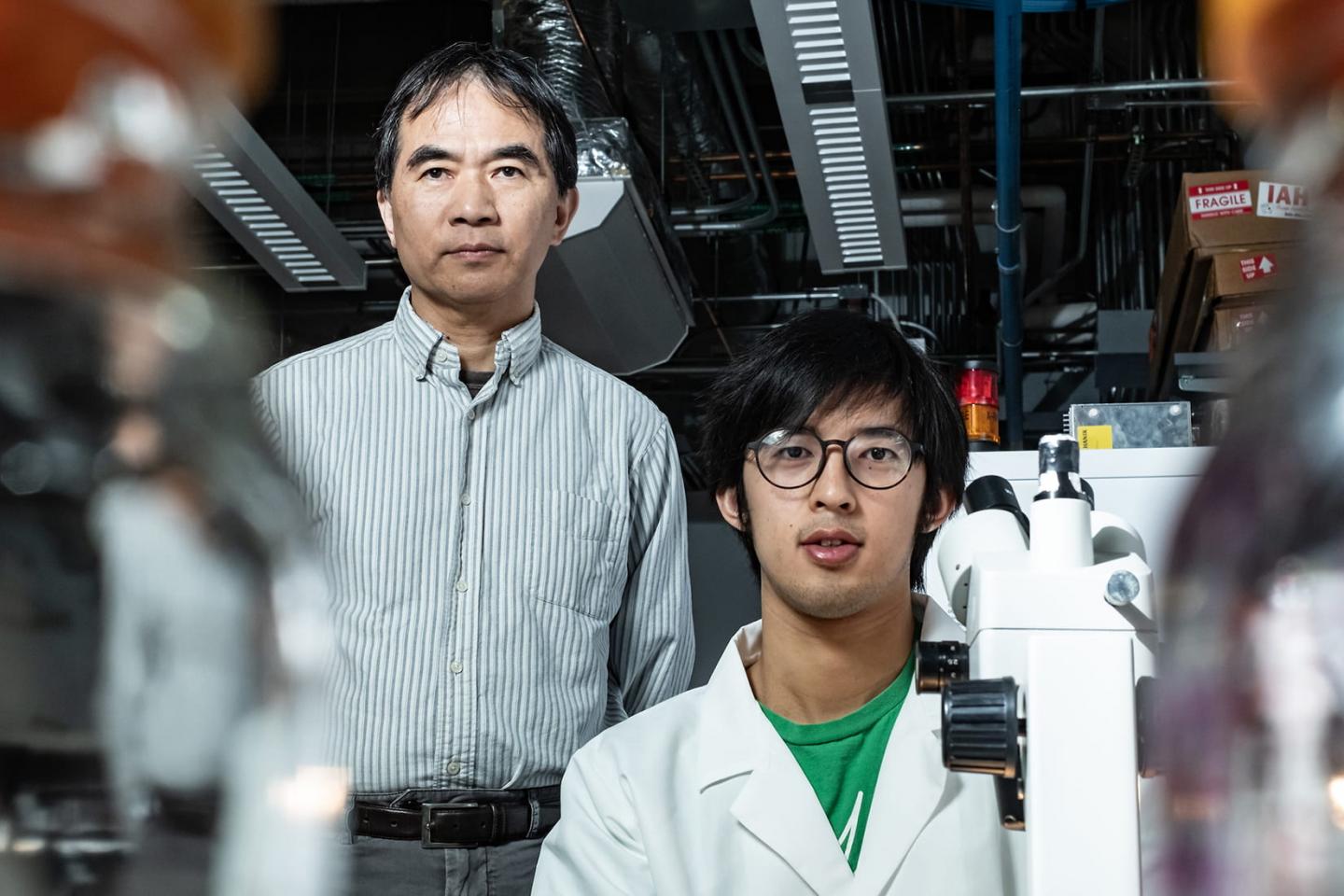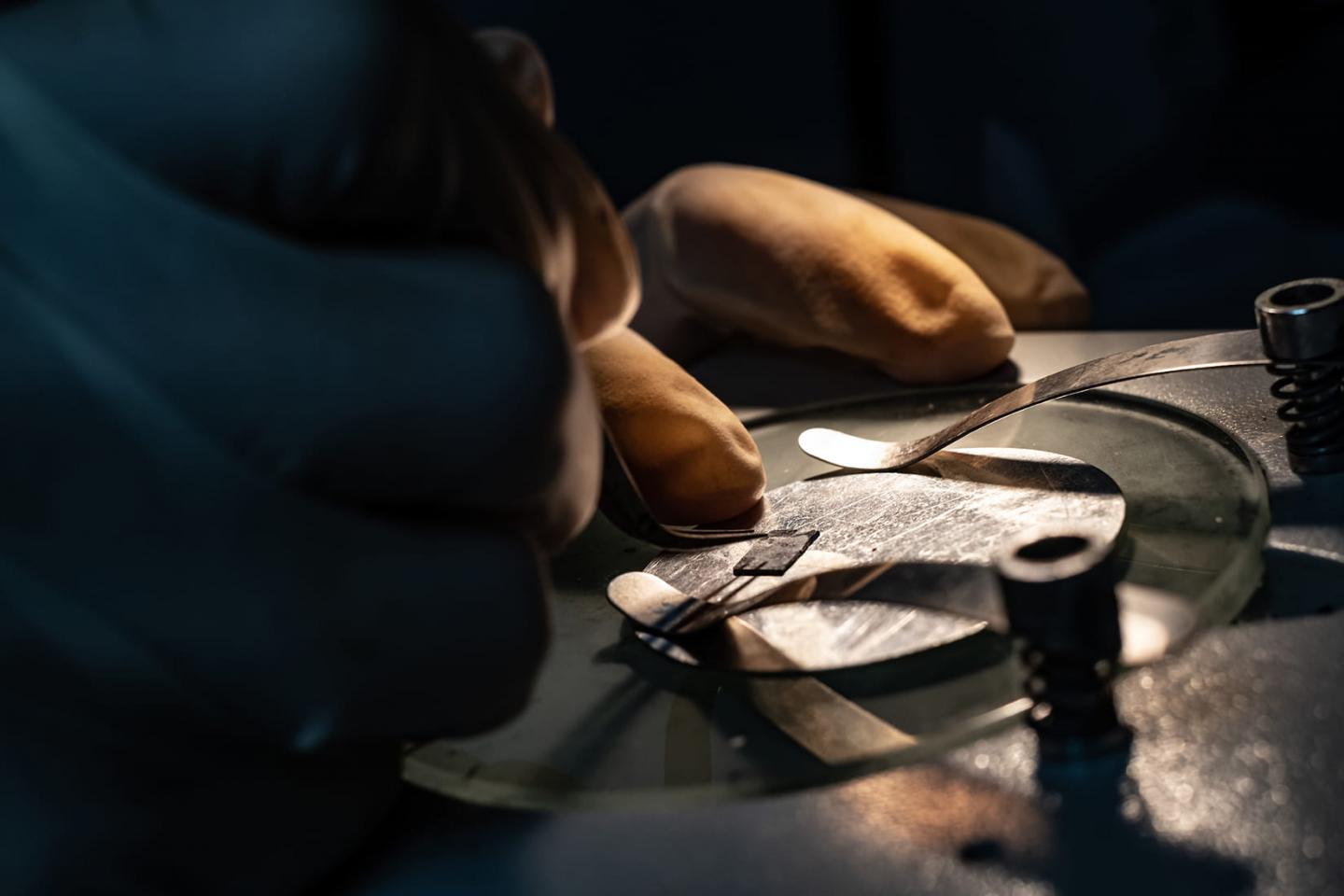For the first time, researchers from Rice University were able to measure the dynamic magnetic properties of iron selenide crystals that had undergone a characteristic structural shift that occurs as the material is cooled, but before it is cooled to the point of superconductivity. Until now, this had been impossible to measure. However, via a complex process involving gluing tiny iron selenide crystals to larger crystals, researcher Tong Chen was able to measure their magnetic properties.

Rice University physicists Pengcheng Dai (left) and Tong Chen conducted neutron scattering experiments with colleagues from the U.S., China and Europe and found that magnetic correlations associated with superconductivity in iron selenide are highly anisotropic, just as they are in other iron-based superconductors. Credit: Jeff Fitlow/Rice University
Dozens of iron-based superconductors have been discovered since 2008. In each, the iron atoms form a two dimensional sheet sandwiched between top and bottom sheets of other elements. In the case of iron selenide, the top and bottom sheets are pure selenium but, in other materials, these sheets are made of two or more elements.
"Iron selenide is completely different from all the other iron-based superconductors in several ways," said Pengcheng Dai, a professor of physics and astronomy at Rice's Center for Quantum Materials; "It has the simplest structure, being composed of only two elements. All the others have at least three elements and a structure that is much more complicated."
In iron selenide and other iron-based superconductors, iron atoms in the central 2D sheet are spaced as if on a chessboard: exactly the same distance from one another in both the left-right direction and forward-back directions. As the materials cool, they undergo a slight structural shift. Instead of exact squares, the iron atoms sit on the corners of oblong rhombuses, as shown in the schematic below.

This change between iron atoms causes the superconductors to
exhibit directionally dependent behaviour such as increased electrical resistance or conductivity only in the left-right or forward-back direction. This directionally dependent behaviour is referred to
as anisotropy or nematicity.
Structural nematicity occurs in iron selenide, but it has previously been impossible to measure the exact electronic and magnetic properties of the material because of a property known as twinning. Twinning occurs when layers of randomly oriented 2D crystals are stacked and their individual differences are averaged out.
The lead author of the study, Tong Chen, a third-year PhD student in Dai's research group, solved the twinning problem by cleverly looking back at a 2014 study in which Dai and colleagues applied pressure to detwin crystals of barium iron arsenide. Although it was impossible to apply the same method to iron selenide because the crystals were 100 times smaller, Chen glued the smaller crystals to the larger ones. He thought that the pressure needed to align the larger sample would also cause the layers of iron selenide to snap into alignment.
It took weeks to create the samples needed for testing. Over 20 squares of iron selenide just one millimetre long had to be aligned and placed on top of each crystal of barium iron arsenide. Applying each of the tiny squares was painstaking work that involved a microscope, tweezers and special hydrogen-free glue that cost almost £1,000 for 50 grams.

Tong Chen, a Rice PhD student "detwinned" iron selenide crystals by gluing them atop much larger crystals of barium iron arsenide. Using a 2014 method developed at Rice, the larger crystals are placed under pressure and detwinned, causing the smaller iron selenide crystals to also snap into alignment. Credit: Jeff Fitlow/Rice University
This complex preparation work paid off when Chen tested the samples and found the iron selenide was detwinned. The group used the MAPS beamline at ISIS, as well as neutron instruments at Oak Ridge National Laboratory, the National Institute of Standards and Technology and the Technical University of Munich.
The experiments also showed iron selenide's electronic behaviour is very similar to that of other iron superconductors. "The key conclusion is that the magnetic correlations that are associated with superconductivity in iron selenide are highly anisotropic, just as they are in other iron superconductors," explains Professor Dai.
"That has been a very controversial point because iron selenide, unlike all other iron-based superconductors, does not have a parent compound that exhibits antiferromagnetic order, which has led some to suggest that superconductivity arose in iron selenide in a completely different way than it arises in these others. Our results suggest that is not the case. You don't need an entirely new method to understand it."
Further Information
The full paper is online at Nature Materials.
